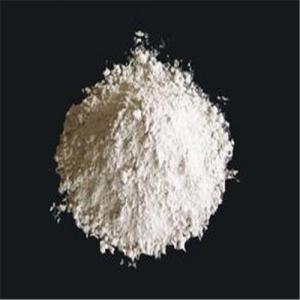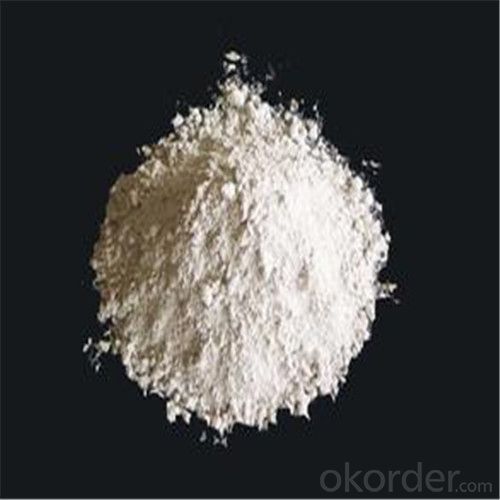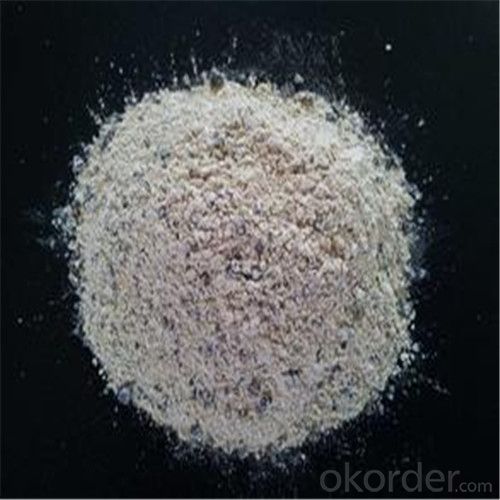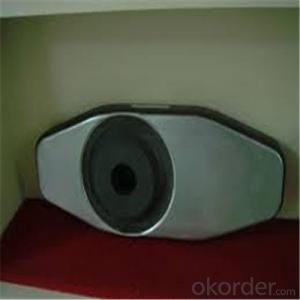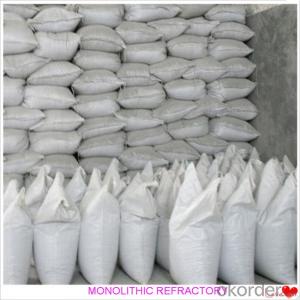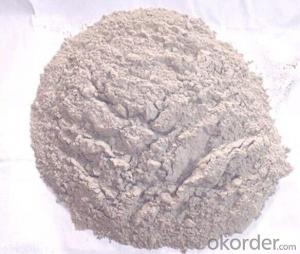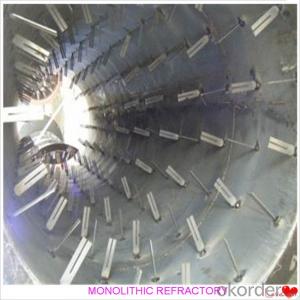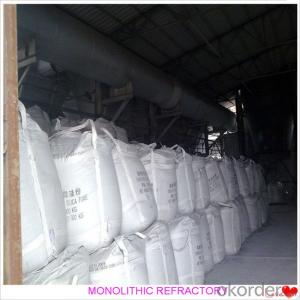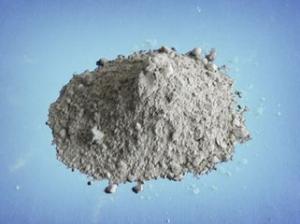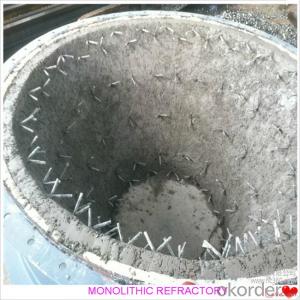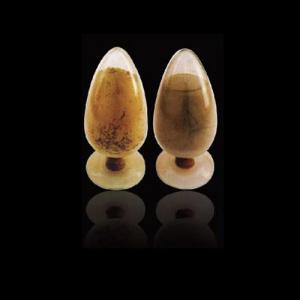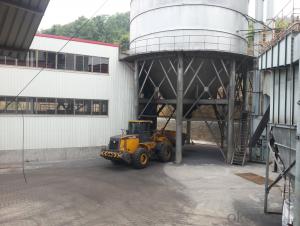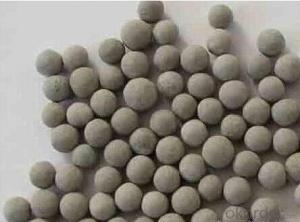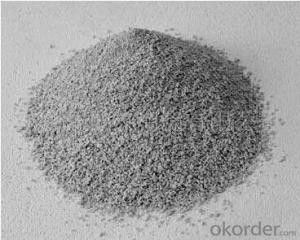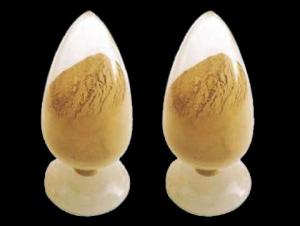Monolithic Refractories for Iron and Steel Industry - Lightweight Castable Refractory Castable by Casting
- Loading Port:
- Shanghai
- Payment Terms:
- TT or LC
- Min Order Qty:
- 20000 kg
- Supply Capability:
- 10000000000 kg/month
OKorder Service Pledge
OKorder Financial Service
You Might Also Like
General Information of Lightweight castable
Lightweight castable is made from lightweight aggregate of lightweight ceramic grains and sand grog and floating beads, mixed with binding agent of aluminate cement and superfine powder, having different aggregates of different materials to meet the design requirements.
Features of Lightweight Castable
◆High strength
◆Good wear resistance
◆Excellent heat-insulation
◆Small reheating liner change
Application of Lightweight Castable
Chimney linings and heat-insulating
Wear proof layers of the
Technical Data of Lightweight Castable
| Technical Data of Lightweight Castable | ||||||
| Physical Properties | LC-1.4 | LC-1.2 | LC-1.0 | LC-0.9 | LC-0.8 | |
| Classification Temperature | ℃ | 1200 | 1100 | 1100 | 1000 | 1000 |
| ℉ | 2190 | 2010 | 2010 | 1830 | 1830 | |
| Buk Densiy(g/cm) | 110℃×24h | 1.4 | 1.2 | 1.0 | 0.9 | 0.8 |
| 815cx3h | 1.3 | 1.1 | 0.9 | 0.8 | 0.7 | |
| Compressive Strength (Mpa) | 110℃×24h | 12 | 10 | 7 | 4.5 | 4 |
| 815cx3h | 10 | 8 | 6 | 4 | 3 | |
| Modulus of Rupture(Mpa) | 110℃×24h | 3 | 2 | 1.5 | 1.0 | 0.8 |
| 815cx3h | 2.5 | 1.5 | 1.0 | 0.8 | 0.5 | |
| Permanent Liner Change (%) | 815℃×3h | 0.2 | 0.2 | 0.2 | 0.2 | 0.2 |
| Thermal Conductivity(W/m.k) | 350℃ | 0.35 | 0.30 | 0.25 | 0.23 | 0.21 |
Photo of Lightweight Castable
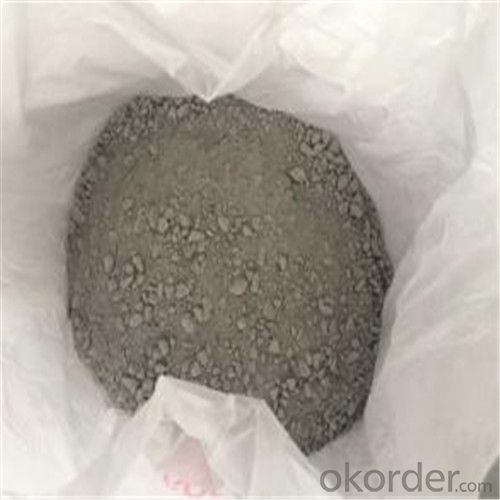
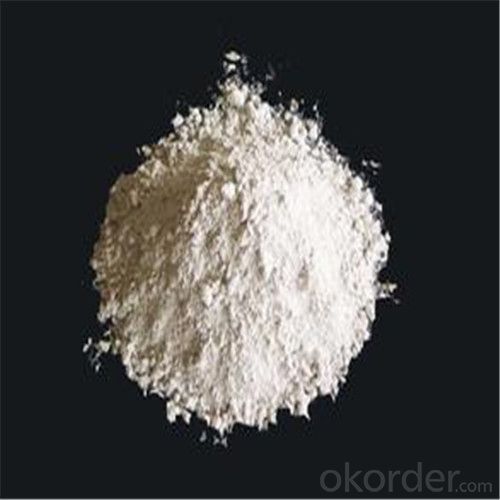
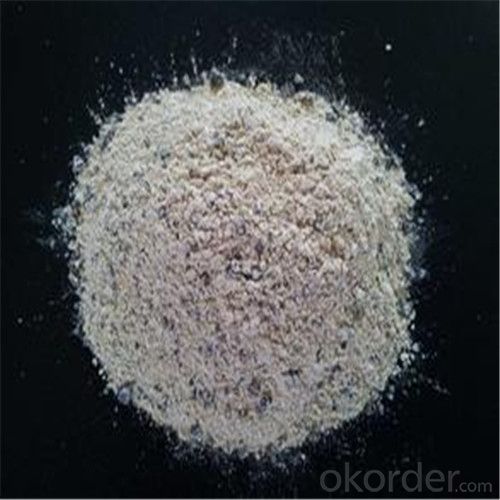
- Q: How are monolithic refractories applied in the hot face and cold face of furnace linings?
- Because of their superior thermal and mechanical properties, monolithic refractories are commonly utilized in furnace linings. These materials are employed in both the hot face and cold face of furnace linings, but their application methods differ for each. When it comes to the hot face of furnace linings, monolithic refractories are applied to endure extreme temperatures and harsh conditions. This area directly faces the heat source and is exposed to the highest temperatures. In this region, the refractory material is specifically engineered to possess excellent thermal conductivity and high resistance to thermal shock. To apply monolithic refractories in the hot face, the commonly used technique is gunning. Gunning involves the spraying or troweling of the refractory material onto the lining's surface. This technique enables quick and efficient application, ensuring a uniform and dense layer of refractory material. Gunning is especially suitable for areas with intricate shapes and contours. On the other hand, the primary concern for the cold face of furnace linings is insulation and protection. The cold face refers to the area that does not directly come into contact with the heat source and experiences lower temperatures. In this area, the refractory material is designed to possess low thermal conductivity and high insulation properties. The application of monolithic refractories in the cold face is typically accomplished using the technique called ramming. Ramming involves compacting the refractory material into place using a pneumatic or hydraulic ramming tool. This technique ensures the creation of a dense and solid layer of refractory material, providing excellent insulation and protection against heat loss. In conclusion, monolithic refractories are vital components of furnace linings as they provide the necessary thermal insulation and mechanical strength required in high-temperature environments. The application techniques of gunning and ramming allow for efficient and effective installation in both the hot face and cold face of furnace linings.
- Q: How do monolithic refractories resist abrasion in the iron and steel industry?
- Monolithic refractories, with their unique composition and properties, are specifically designed for the iron and steel industry to resist abrasion. Made from a single homogeneous material, they exhibit exceptional strength and durability when subjected to continuous abrasion. The high density of monolithic refractories is one of the key factors contributing to their abrasion resistance. These refractories are manufactured with tightly packed particles, resulting in a solid and compact structure. This density minimizes wear and tear caused by the constant movement of materials like iron and steel. Furthermore, monolithic refractories often contain high levels of alumina, known for its excellent resistance to abrasion. Alumina is a highly refractory material that can withstand high temperatures and mechanical stress without deteriorating. Its presence in monolithic refractories creates a protective layer that resists abrasion caused by the movement and impact of iron and steel particles. In addition, monolithic refractories can be designed with specific additives and binders that further enhance their resistance to abrasion. These additives may include silicon carbide, mullite, or zirconia, which are renowned for their superior mechanical strength and ability to withstand wear. The binders used in the manufacturing process also contribute to the refractory's integrity and its ability to resist abrasion by providing a cohesive structure. In conclusion, the combination of high density, alumina content, specialized additives, and binders makes monolithic refractories highly resistant to abrasion in the iron and steel industry. They can withstand the harsh conditions and constant movement of materials, ensuring long-lasting performance and efficiency in various applications within the industry.
- Q: How are monolithic refractories used in the repair and maintenance of ladle and tundish covers?
- Due to their excellent thermal resistance and durability, monolithic refractories are commonly utilized for repairing and maintaining ladle and tundish covers. These covers play a crucial role in the containment of molten metal and the prevention of heat loss during the steelmaking process. When exposed to high temperatures and thermal cycling, ladle and tundish covers can undergo wear and tear, resulting in cracks, spalling, or even complete failure. This is where monolithic refractories come into play. Monolithic refractories are refractory materials that are not shaped and can be easily molded and applied to damaged areas of ladle and tundish covers. They can be cast, gunned, or sprayed onto the surface, enabling quick and efficient repairs. Typically, these refractories consist of a matrix material, such as alumina, silica, or magnesia, along with various additives and bonding agents. The specific composition depends on the application requirements and severity of operating conditions. The repair process begins by identifying the damaged areas of the ladle or tundish cover. Any loose or damaged refractory material is removed, and the surface is prepared for the application of the monolithic refractory. This may involve cleaning, roughening, or even preheating the surface, depending on the specific requirements. The monolithic refractory is then mixed with water or a suitable binder to achieve a workable consistency. It is then applied to the damaged areas using the appropriate method, such as casting or spraying. After application, the refractory material is allowed to dry and cure, typically through controlled heating. Once cured, the monolithic refractory forms a robust and durable lining that can withstand the high temperatures, thermal cycling, and chemical reactions occurring during ladle and tundish operation. It provides excellent thermal insulation, minimizing heat loss and reducing energy consumption. Moreover, monolithic refractories exhibit superior resistance to slag, metal penetration, and erosion, ensuring extended service life for ladle and tundish covers. They also possess good thermal shock resistance, enabling them to endure rapid temperature changes without cracking or spalling. In conclusion, monolithic refractories are indispensable for repairing and maintaining ladle and tundish covers due to their thermal resistance, durability, and ease of application. Their ability to withstand high temperatures, thermal cycling, and chemical reactions ensures the integrity and efficiency of ladle and tundish operations in the steelmaking industry.
- Q: How do monolithic refractories contribute to the overall productivity of iron and steel production?
- Monolithic refractories play a crucial role in enhancing the overall productivity of iron and steel production. These refractories are widely used in various applications such as furnaces, ladles, and tundishes, offering excellent thermal stability and resistance to chemical attacks. By providing a durable lining, monolithic refractories ensure longer campaigns and reduced downtime for repairs and maintenance. This leads to increased production efficiency, reduced energy consumption, and improved product quality, ultimately contributing to the overall productivity of iron and steel production.
- Q: What are the typical applications of monolithic refractories in the iron and steel industry?
- Various applications within the iron and steel industry widely utilize monolithic refractories. These refractories, composed of a single material, offer numerous advantages including easy installation, thermal shock resistance, and excellent resistance to chemical attacks. Below are some typical applications of monolithic refractories in the iron and steel industry: 1. Blast Furnace: In blast furnaces, monolithic refractories line the interior and endure extreme temperatures and chemical reactions. They provide thermal insulation, prevent erosion, and resist the corrosive effects of molten iron and slag. 2. Ladles and Tundishes: Monolithic refractories line ladles and tundishes, vessels used for transporting and transferring molten metal. These refractories offer effective thermal insulation and resistance to erosion and chemical attacks, ensuring the integrity of the vessels. 3. Steelmaking Converters: Converters, essential in the steelmaking process to convert molten pig iron into steel, utilize monolithic refractories. These refractories provide protection against high temperatures and aggressive chemical environments encountered during the process. 4. Electric Arc Furnaces (EAF): Monolithic refractories line the walls and roofs of EAFs, used to recycle scrap steel by melting it. These refractories offer outstanding thermal insulation, resistance to slag erosion, and thermal shock resistance, ensuring the longevity and efficiency of the furnace. 5. Continuous Casting: Monolithic refractories find employment in the continuous casting process, where molten steel solidifies into a continuous slab or billet. These refractories line the walls and floors of the casting molds, providing thermal insulation and resistance to chemical attacks from the molten steel. 6. Reheating Furnaces: Monolithic refractories are used in reheating furnaces, which heat steel billets or ingots prior to further processing. These refractories provide insulation, high-temperature resistance, and ensure uniform heating of the metal. Overall, monolithic refractories play a crucial role in the iron and steel industry by providing reliable and durable linings in various applications. Their ability to withstand extreme temperatures, chemical attacks, and thermal shocks makes them indispensable for maintaining the integrity and efficiency of the production processes.
- Q: What are the limitations of monolithic refractories in high-temperature applications?
- Monolithic refractories are renowned for their versatility and ease of installation, which has made them a popular choice in various high-temperature settings. However, it is important to take into account their specific limitations. To begin with, monolithic refractories have a restricted ability to withstand thermal shock. Significant temperature changes, such as those encountered during start-up or shutdown procedures, can subject them to thermal stress, resulting in cracking or spalling. This can be a significant issue in scenarios where the refractory is exposed to frequent temperature fluctuations. Moreover, monolithic refractories possess comparatively lower mechanical strength in comparison to traditional brick or block refractories. This can lead to a diminished ability to withstand mechanical stress, including abrasion or impact, particularly in high-temperature environments. Consequently, they may not be suitable for applications that involve high mechanical loading or abrasive conditions. Another drawback of monolithic refractories is their vulnerability to chemical attack. Certain aggressive chemical environments can trigger chemical reactions with the refractory material, leading to deterioration or corrosion. This becomes a concern in applications that involve acidic or alkaline substances, where specialized refractory materials may be necessary. Additionally, monolithic refractories are more susceptible to spalling or erosion caused by thermal cycling. The repetitive expansion and contraction of the refractory material due to temperature changes can result in the formation of cracks or gaps, making them more prone to erosion from gases or liquids. This limitation must be carefully considered in applications where long-term durability is crucial. Lastly, repairing or replacing monolithic refractories can be challenging compared to brick or block refractories. Once installed, removing and replacing a monolithic lining can prove difficult, especially in complex shapes or confined spaces. This limitation can lead to prolonged downtime or increased maintenance and repair costs. In conclusion, while monolithic refractories offer numerous advantages in high-temperature applications, they also come with limitations in terms of thermal shock resistance, mechanical strength, chemical resistance, erosion, and repairability. It is crucial to thoroughly assess these limitations to ensure the suitability of monolithic refractories for specific application requirements.
- Q: How do monolithic refractories perform in electric arc furnace roof applications?
- Monolithic refractories are highly effective in electric arc furnace (EAF) roof applications due to their unique properties and characteristics. These refractories, which are composed of a single, solid material, offer several advantages in this specific application. Firstly, monolithic refractories provide excellent thermal insulation, which is crucial in EAF roof applications. The intense heat generated in the furnace can cause structural damage to traditional brick refractories, but monolithic refractories have a higher resistance to thermal shock, reducing the risk of cracking and spalling. This allows them to maintain their integrity and insulation properties even in extreme temperature conditions. Moreover, monolithic refractories have high strength and abrasion resistance, ensuring their durability and longevity in EAF roof applications. The roof of an electric arc furnace is exposed to harsh conditions, including the impact of scrap materials and the erosive effect of molten metal and slag. Monolithic refractories are designed to withstand these challenges, offering superior resistance to mechanical wear and erosion. Another advantage of monolithic refractories is their ease of installation. Unlike traditional brick refractories, which require time-consuming and complex installation processes, monolithic refractories can be applied quickly and efficiently. They can be cast, gunned, or sprayed onto the roof surface, conforming to any shape or contour, thus reducing downtime during installation or repair. Furthermore, monolithic refractories provide increased energy efficiency in EAF roof applications. Their superior insulation properties minimize heat loss, resulting in reduced energy consumption and cost savings. This is particularly important for electric arc furnaces, as they rely on high temperatures to melt and process metals, and any heat loss can significantly impact the efficiency and productivity of the furnace. In conclusion, monolithic refractories are highly suitable for electric arc furnace roof applications due to their exceptional thermal insulation, strength, abrasion resistance, ease of installation, and energy efficiency. These refractories offer significant advantages over traditional brick refractories, ensuring optimal performance and prolonged service life in the demanding environment of an electric arc furnace.
- Q: What are the specific requirements of monolithic refractories for ladle transfer applications?
- To ensure the effectiveness and durability of monolithic refractories used in ladle transfer applications, specific requirements must be met. These requirements are crucial for maintaining the integrity of the ladle lining and preventing any issues during the transfer process. Firstly, it is essential for monolithic refractories designed for ladle transfer applications to possess excellent thermal shock resistance. Ladles undergo extreme temperature changes during the transfer process, and the refractories must be capable of withstanding rapid heating and cooling without developing cracks or spalling. This property serves to prevent any damage to the lining and preserves the structural integrity of the ladle. Secondly, ladle transfer applications necessitate monolithic refractories that exhibit high resistance to chemical attack. Ladles often come into contact with various molten metals and slag, which can possess corrosive properties. The refractories must be able to endure these corrosive environments and maintain their physical and chemical properties over time. Another crucial requirement is good mechanical strength. Ladles can experience significant mechanical stress during the transfer process, including impacts and vibrations. Therefore, the monolithic refractories must possess sufficient strength to resist these mechanical forces and prevent any cracking or failure within the lining. Furthermore, ladle transfer applications frequently involve the use of fluxes and additives, which can possess different physical properties. The refractories used must be compatible with these fluxes and additives to ensure proper performance and avoid any adverse reactions that could impact the lining of the ladle. Lastly, monolithic refractories designed for ladle transfer applications should exhibit low porosity. Low porosity helps to minimize the penetration of molten metal and slag into the refractory lining, thereby reducing the risk of erosion and extending the service life of the refractories. In summary, the specific requirements for monolithic refractories in ladle transfer applications include excellent thermal shock resistance, high resistance to chemical attack, good mechanical strength, compatibility with fluxes and additives, and low porosity. By meeting these requirements, the refractories can effectively endure the harsh conditions of ladle transfer and ensure the longevity and performance of the ladle lining.
- Q: What are the advantages of using monolithic refractories in the iron and steel industry?
- There are several advantages of using monolithic refractories in the iron and steel industry. Firstly, monolithic refractories offer excellent thermal insulation properties. This means that they are able to withstand and retain high temperatures, which is crucial in the iron and steel manufacturing process. The ability to withstand extreme heat ensures that the refractories maintain their structural integrity, reducing the risk of failure and maintaining operational efficiency. Secondly, monolithic refractories have superior corrosion resistance. In the iron and steel industry, where materials are exposed to harsh chemicals and corrosive agents, the use of monolithic refractories helps to protect the equipment and structures from degradation. This not only extends the lifespan of the refractories but also reduces maintenance costs and downtime. Another advantage of monolithic refractories is their versatility. Unlike traditional refractory bricks, which are rigid and require skilled labor for installation, monolithic refractories can be cast or sprayed into various shapes and sizes. This flexibility allows for easier installation and customization, resulting in better lining design and improved performance. Additionally, monolithic refractories can be easily repaired or patched in case of damage, minimizing production disruptions. Furthermore, monolithic refractories have excellent mechanical strength and abrasion resistance. In the iron and steel industry, where materials are constantly being moved and processed, the refractories must be able to withstand mechanical stresses and abrasion. Monolithic refractories provide the necessary strength and resistance, ensuring that they can withstand the rigors of the industry without compromising performance. Lastly, the use of monolithic refractories in the iron and steel industry can lead to cost savings. Due to their versatility and ease of installation, monolithic refractories require less labor and time for installation, resulting in reduced installation costs. Additionally, their longer lifespan and resistance to corrosion and thermal shock minimize the need for frequent replacements, reducing maintenance and downtime costs. In conclusion, the advantages of using monolithic refractories in the iron and steel industry include excellent thermal insulation, corrosion resistance, versatility, mechanical strength, and cost savings. These benefits make monolithic refractories an ideal choice for lining furnaces, ladles, and other equipment used in the production of iron and steel.
- Q: How do monolithic refractories improve the efficiency of ladle and tundish drying furnaces?
- Monolithic refractories improve the efficiency of ladle and tundish drying furnaces by providing excellent thermal insulation, high resistance to thermal shock, and superior strength. These properties ensure minimal heat loss during the drying process, allowing for faster and more efficient heating. Additionally, monolithic refractories offer better resistance to erosion and corrosion, prolonging the lifespan of the furnaces and reducing maintenance requirements. Overall, the use of monolithic refractories enhances the performance and productivity of ladle and tundish drying furnaces.
Send your message to us
Monolithic Refractories for Iron and Steel Industry - Lightweight Castable Refractory Castable by Casting
- Loading Port:
- Shanghai
- Payment Terms:
- TT or LC
- Min Order Qty:
- 20000 kg
- Supply Capability:
- 10000000000 kg/month
OKorder Service Pledge
OKorder Financial Service
Similar products
Hot products
Hot Searches
Related keywords
